#i will never be an academic validation girly i fear
Explore tagged Tumblr posts
Text
every day i try to be a pomodoro lofi beats lifeat pastel highlighted notes person. every day i'm victor hugo procrastinating everything till last minute, taking all my clothes off and asking my assistant to hide them until i finish the assignment because without drastic measures i literally have no self control
14 notes
·
View notes
Text
Rambling About Characters I Haven't Drawn/Talked About Much Yet!!!
(because I have nothing to do-)
______________________________________________________________
Aqua Diggins Mary
Job: Unemployed
Random Info: Adopted by the Mary Family, has an ability where she can understand and talk to dogs, always quits her job after a month or two as she has no idea what she wants to do with her life, used to be extremely girly in highschool
Personality: She's quite calm but isn't incapable of losing her temper, she's very overprotective over her sister, feels isolated most of the time but she doesn't mind it most of the time, sometimes brutally honest
Fears: Dragons, heights, her sister losing herself
Mr. Somebody
Job: Wall Employee
Random Info: Got divorced then remarried the same person, his real name is Aaron Greyson but everybody at work forgot his name so they just started calling this, his hair is covering his face due to it being literally just ink, if he feels any extreme emotion other then sadness he will slowly turn into a monster and then die, father to Lexi and Aqua (though neither are biologically related to him)
Personality: He's miserable, he really just needs someone to cheer him up, he's honest but very quiet, usually stays alone from both being used to it and just liking being alone, very open-minded, never really expresses his emotions even to his wife and kids
Fears: His father, what happens after death, his family being taken away from him
Bruno Izzy Orange
(yes, I gave her that name before realizing that was more of a guy name, but at that point I already was calling her that for years)
Job: Government (I don't have specifics lmao)
Random Info: Dating a girl named May, lives with her girlfriend in an apartment, not much of a talker unless you work with her, only really has work relationships then anything else, great with physical fighting and with a pistol, terrible with any other weapon
Personality: She's pretty book smart and street smart, only really lets her "tough and cold" persona down around May, often teases her close friends off work, not completely insecure but certainly wishes she was someone else, hates telling anything personal about herself
Fears: Cyborgs, injuries that can lead to scarring, bombs
May Baggins
Job: Unemployed
Random Info: Owns hundreds of plushes, isn't sure if she would rather join the Toppat Clan or not but went with being unemployed due to her girlfriend, pathetically weak, always uses her girlfriend as a shield, in slight debt, "homeschooled", has a terrible past with her father...
Personality: A little nervous wreck, she can't handle stress, if embarrassment was a person it would be her, when calm she's very sweet, very close-minded, extremely insecure, surprisely alright with telling her past if you don't mind her stuttering and crying a lot
Fears: Hard decisions, small spaces, fire, water, heights
Morena Elone
Job: Toppat
Random Info: This is the weirdest OC I have created, would do (almost) anything for money, not actually a gold digger but everybody thinks she is, needs glasses/contacts but refuses to get them, saving for college because her family didn't give her anything, had academic validation in childhood
Personality: Acts like a complete dumbass but she's actually very smart, gets bored easily, kind of a dickhole, not insecure in her looks but absolutely insecure with everything else, is capable of feeling guilt but others constantly portray her as heartless, love disgusts her but is also extremely flirty and touch starved
Fears: Strangers, her family, being truly vulnerable
Jack Oliver Cinder
Job: Government (Fixes helicopters!!)
Random Info: Engaged to Charles Calvin, owns a pet Cockatiel named Pika, his birthday is on Halloween, loves murder mystery shows/games, doesn't trust the city that much
Personality: Playful, can be a bit negative at times but always tries to be realistic no matter what, tries to be open-minded but can be very judgmental, a bit of a troublemaker if he gets too curious, always curious about magic but is a little skeptical about it
Fears: Ghosts, Toppat Clan, Charles getting hurt, spiders
Cinnamon Cinder
Job: Government Spy
Random Info: Mentions she has dreams about the future but nobody believes her, absolutely obsessed with magic, currently pretending to be a Toppat member on the rocket but a certain someone knows she's a spy... but they refuse to reveal she's one
Personality: Very sweet, a bit of a scatterbrain, seems very cheerful but she's also a depressing gal, seems very forgetful but remembers everything, loyal to her siblings
Fears: Death, being misunderstood
.
.
.
.
.
.
.
[YOU GOT A MESSAGE! WOULD YOU LIKE TO OPEN IT?] [[YES]] [NO]
"Uh... hello? Is this working? I'm Cinnamon Cinder! Just call me Cinna. I can't tell where I am... there's no clouds, but no fire. All I see is colors... colors and colors. I want out, does anybody know how I can get out! Please I'm calling for help, I need it. I know you guys probably don't know me but I really need your help-"
[MESSAGE DELETED] [WHOOPS! THAT WAS SUPPOSED TO BE GONE ALREADY, HOPEFULLY THIS DOESN'T GET ME FIRED.] [CLOSING...]
#henry stickmin#henry stickmin au#thsc#the henry stickmin collection#henry stickmin oc#thsc au#thsc oc#aqua mary#mr somebody#bruno orange#may baggins#morena elone#jack cinder#cinnamon cinder
3 notes
·
View notes
Photo
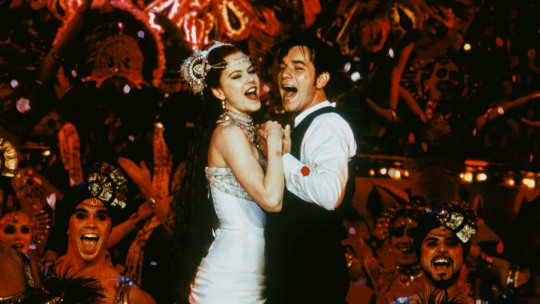
Spectacular Spectacular!
On the twentieth anniversary of its explosion onto big screens, Ella Kemp high-kicks into the Moulin Rouge! once again, accompanied by screenwriter Craig Pearce and a chorus line of jukebox-musical academics and swoony Letterboxd fans.
“You’re always writing for yourself, for the film you want to see. I like all kinds of different films and I think teenage girls do too.” —Craig Pearce, Moulin Rouge! co-writer
This is a story about love. A love born at the turn of the twentieth century in an iconic Parisian cabaret and brought to life in 2001 on Australia’s most spectacular sound stage. A valentine to excess, greed, fantasy and, above all, to the fundamental Bohemian ideals: truth, beauty, freedom and love. This is the story of Moulin Rouge! and how it still burns bright, two decades on, in the hearts of romantics all over the world.
The film, a fateful love story between penniless writer Christian and dazzling courtesan Satine—played by Ewan McGregor and Nicole Kidman—premiered at the Cannes Film Festival on May 9, 2001 and opened in New York and Los Angeles cinemas only weeks later, on May 18. Cast and crew fought hard to get it there: unimaginably, writer-director Baz Luhrmann’s father passed away on the first day of filming, and Kidman’s then-marriage was in turmoil. “There were times of beautiful moments, but there were times where we were like, ‘This is so hard’,” Luhrmann recently told an Australian journalist.
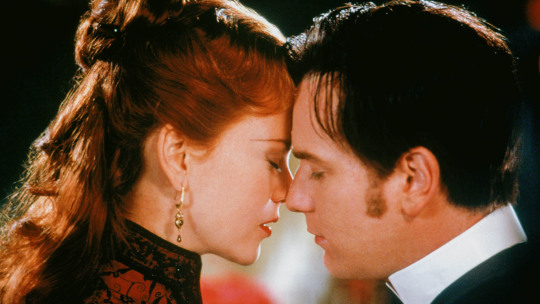
And, though this seems strange to say in a world that has since welcomed Mamma Mia!, Bohemian Rhapsody and Rocketman, making a movie musical early in the millennium was a high-risk pursuit. Luhrmann again: “‘Musicals will never be popular again’ … I can’t tell you how many times I was told that.”
“It’s part of a cycle,” explains Dr. Eleonora Sammartino, an academic specializing in contemporary American film musicals. “It came after a period in the 1990s where musicals had disappeared from the big screen.” Lisa Duffy, Letterboxd member and Doctor of Hollywood Musicals, agrees: “Films coming out [that year] were a lot more dour, so this was a real gamble.”
Nobody understood this gamble better than the film’s co-writer, Craig Pearce, who has been Luhrmann’s close friend and professional partner since the pair were students together. Moulin Rouge! is the third and final entry in what we now know as their red-curtain trilogy, alongside Strictly Ballroom (1992) and Romeo + Juliet (1996).
“Baz had been thinking about the parallels between the Moulin Rouge and Andy Warhol’s Factory,” Pearce recalls. “Places where artists congregate, where it’s more than a place, it’s a petri dish of creativity. Like The Factory, and Studio 54, the Moulin Rouge was a place where the old and the wealthy pay a lot of money to hang out with the young and the sexy.”
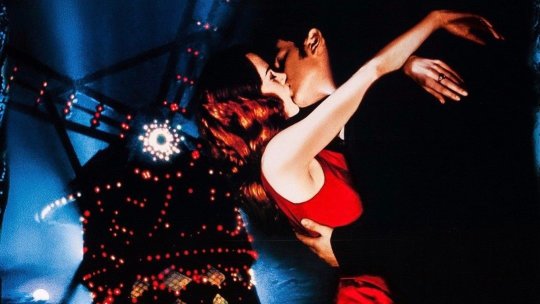
At the end of the twentieth century, however, the Moulin Rouge wasn’t all that great (the original had burnt down in 1915). Pearce recalls: “We went to Paris in 1999 on a research trip and discovered, to our horror, that the Moulin Rouge now is just a hideous tourist trap. So we had to go on this journey to find out how this amazing creativity—artists and dancers and musicians—came out of what now feels like this tawdry girlie show.”
With the location and period locked in, Pearce and Luhrmann worked to find the story’s driving force. “This movie wouldn’t work without the exclamation point,” writes Adelaide. Pearce is the first to admit this: “It’s saying it’s Moulin Rouge, but it’s not that one. What we’re trying to do is heighten truth, but you have to start with that underlying truth,” he explains. “It’s not casting around for ‘what would be a cool idea’ because you never come up with one. It’s never as interesting as the truth. Like, there was an elephant in the garden of the Moulin Rouge. And why does that matter? It matters because there are certain inherent logics in the way human beings operate.”
“It's a musical of recycled parts. It’s a story which, beat for beat, has been told for centuries. It’s a staged show drawn from the lives of the characters themselves… This is a film [that] is bold enough not just to say that all art is about finding your own meanings behind someone else’s ideas, and that all art is just copying and stealing, but that this can be totally valid and authentic. When Nicole Kidman sings ‘Your Song’ to the Duke, she’s stealing from the writer, and Luhrmann is stealing from Elton John. But when Ewan McGregor is singing to Kidman, it’s the most magical moment you could possibly imagine. That’s what makes ‘Moulin Rouge!’ a true masterpiece. Cinema has never been more fake, and cinema has rarely been more real.” —Sam
Moulin Rouge! borrows from all over. There are hints of La Traviata, of Cabaret and of Émile Zola’s Nana. There were Toulouse Lautrec’s paintings (John Leguizamo tremendously embodies the painter in the film), Baudelaire and Verlaine’s literature, Jason and the Argonauts, Homer’s Odyssey, and the revues of the 1920s and ’30s. “Moulin Rouge! really embraces that vaudevillian component,” says Dr. Hannah Robbins, a Broadway and Hollywood musicals specialist.


Craig Pearce and Baz Luhrmann writing in Paris (1998) and New York (2019). / Photos from Luhrmann’s Twitter
“This genre lends itself to repetition and fragmentation,” Sammartino expands. “It’s part of the syntax of the musical and has always been, this idea of borrowing from other sources. This doesn’t take away from the daring postmodern approach Moulin Rouge! is defined by, it’s simply further proof that it’s, well, a very good musical.”
Above all else, the core of Moulin Rouge! is inspired by the myth of Orpheus of Thrace and his doomed love affair with the beautiful Eurydice, whom he followed into Hades after she died. “The show must go on, Satine,” the nightclub’s impresario Harold Zidler grimly tells his star, as their world begins to crumble. “We’re creatures of the underworld. We can’t afford to love.”
It wasn’t the first time Pearce and Luhrmann had looked to ancient mythology. Strictly Ballroom’s mantra, which tells us “a life lived in fear is a life half lived” owes everything to David and Goliath. But with the Orphean myth, the screenwriters were looking to dig deeper, to find something much darker. “The Orphean myth is a romantic tragedy in its essence,” Pearce explains. “David and Goliath is more youthful, and it’s about saying that belief can conquer anything. But as you get older people get sick, they die, and life is about resilience and finding ways to embrace the hard things in life and move forward.”
That might sound antithetical to the all-singing, all-dancing nature of the movie musical, but the genre has been trying to tell devastating stories like Moulin Rouge! for decades. “Hollywood is rarely interested in buying and remaking stories with devastating endings as much as stage musicals are,” Duffy explains. (See: Les Misérables, Phantom of the Opera.)

This reluctance can be traced back to the classic era, during which there were rules about the ways a musical could end under the censorship laws of the Production Code. Simply put, they had to have a happy ending. (Which also led to a fair amount of bizarre deus ex machina to guarantee a nice, cheery final act).
But then in the 1960s the Code fades away, and Hollywood starts engaging with violence, sex and explicit trauma on-screen. “We have much more freedom in the contemporary era to have people die explicitly,” Duffy says. “And that’s why we keep returning to Moulin Rouge!: there’s the explicit negotiation of our entry into the fantasy world, and then we’re devastated, and the curtains close and we’re in reality again.”
“It’s one of the great 21st-century films. Baz Luhrmann is only good when figuring out how to make historical periods of excess into contemporary displays of grotesquerie, somehow turning great films (‘French Cancan’) or great literature (‘The Great Gatsby’) into tacky Technicolor vomit that somehow understands the underlying sorrow of the material better than any serious-minded adaptation.” —Jake
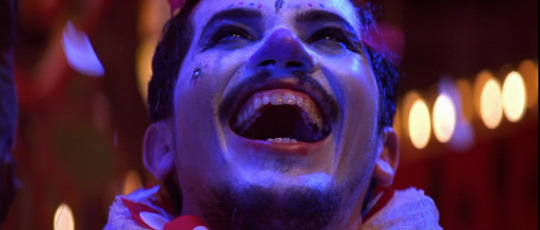
The red-curtain trilogy has a distinct set of rules: one, the viewer must know how the film ends from the start; two, the story must be set in a heightened world; and three, it must contain a device that keeps the audience awake at all times, whether that be ballroom dancing, scattershot Shakespearean dialogue, or pop songs.
“Part of the appeal of the artifice is that it gives the audience permission to say, ‘This isn’t real, you’re about to see a fantasy, and that’s okay,’” Duffy says. “The pleasure is the fantasy of it. The whole film is us seeing how Christian is imagining what happened—and the musical is the most extreme genre that allows such imagination.”
The point was never to temper the elaborate, hyper-aware fakeness of it all, but to really commit to it. Says Robbins, “Musicals are ultimately artificial and exclusively constructed. And that’s what Moulin Rouge! achieves and quite a lot of films don’t. It goes, ‘This is where the story is going, this is the energy, this will be played in the soundtrack.’ There’s a deliberate thought process there.”
Luhrmann recently said: “The way we made the movie is the way the movie is.” An under-explored aspect of Moulin Rouge! is how the whole affair, with its ‘Spectacular Spectacular’ musical-within-a-musical device, is an insider’s guide to the mechanics and politics of making ‘big art’. How money can control both the art (the dastardly Duke insisting on “his” ending), and the artists (Satine is never told she is dying, because she is the golden goose upon whose shoulders the success of the company rests; Christian is likewise left in the dark, because he is the scriptwriter who needs to finish writing the show. Both are wrung dry for their talents).
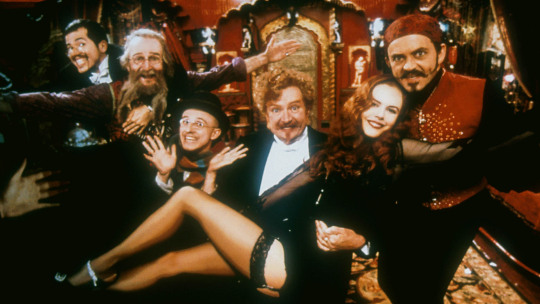
There are shades of Luhrmann in Zigler, the impresario juggling cast, crew, investors and opening dates (Moulin Rouge! was originally slated for December 2000). Christian and friends in playwriting mode are surely Pearce and Luhrmann themselves, searching for the most economical way to say “the hills are vital, intoning the descant”.
And, from the show-within-a-show rehearsals, to the bustle of the backstage, to the gun-chase through the wooden bones of the fly tower, the production details are Catherine Martin to the very last diamante. Nobody does daring bedazzlement quite like ‘CM’, Luhrmann’s fellow producer and life partner. Electricity was the new, exciting thing in Paris at the turn of the twentieth century and this film was lit.
A necklace worn by Satine as a gift from the Duke was made of real diamonds and platinum. Designed by Stefano Canturi, It was the most expensive piece of jewellery ever specifically made for a film, with 1,308 diamonds weighing 134 carats, and worth an estimated one million dollars. Needless to say, Martin won both costume and production design Oscars for the film.

Also among the film’s eight Academy Award nominees: editor Jill Bilcock, about whose singular craft there is a recent documentary. Her breathless, kaleidoscopic cutting (also deployed in Strictly Ballroom and Romeo + Juliet) dropped us right on the dance floor; one 65-second sequence contained a boggling 85 cuts. And this is on the back of her superbly judged opening, a scene that repeats itself as she places Christian at both the start of his love story, and its devastating aftermath—heartbroken, unshaven, self-medicating, reaching for the words to begin making sense of his loss.
“I wondered, for the first hour of this, how Baz Luhrmann had managed to balance such in-your-face stylistic audacity while maintaining a genuine feeling of care for the characters and their struggles—is it all down to Ewan McGregor’s wonderfully earnest face, or the way Nicole Kidman’s smouldering-temptress persona is worn down by one of the most charming cinematic uses of Elton John’s ‘Your Song’? But as the ‘Elephant Love Medley’ transformed into David Bowie’s ‘Heroes’, I stopped caring, I just swooned.” —Kat
If electricity was the thing that drove the kids wild in the 1900s, the internet was on everyone’s minds in 2001. We were just figuring out how to juggle tabs and text people. The real magic dust sprinkled throughout Moulin Rouge! is, obviously, the cacophonous soundtrack, which made sense to our collective, fragmented consciousness.
“No other musical of the modern era has so perfectly captured the sense of spinning an iPod wheel every 45 seconds to play something else,” writes Jake of the medley of songs by David Bowie, Fat Boy Slim, Nirvana, Police, Elton John, Rufus Wainwright, Madonna and many others.
Luhrmann and Pearce stopped at nothing to get every single track from every single artist they wanted. The journey took more than two years, and some bodies were left at the side of the road. “You constantly have to kill your darlings,” Pearce sighs. RIP to Rod Stewart’s ‘Tonight’s the Night’, The Rolling Stones’ ‘Under My Thumb’, Prince’s ‘Raspberry Beret’ and Fifth Dimension’s ‘Up, Up and Away’. (Hot air balloons were big in 2001.)
"We wanted the music to be modern, because we didn’t want it to feel like a fusty, crusty world,” says Pearce. “We wanted to find the universal modern parallels that have existed since time immemorial.” But it wasn’t just about finding the most popular songs at the time. “The structure had to be driven by the needs of the story,” the screenwriter explains. “The musicals on film that tend to fail are the ones where the music feels like a film clip. If it’s not serving the emotional needs of the story, you very quickly check out and it becomes boring. With good musical storytelling, it builds and builds to a point where you can’t do anything but express yourself through song.”

Has there ever been a more desperately romantic promise than when Christian starts telling Satine he doesn’t have much to give her, before nailing that one perfect high note to reassure her that his gift is his song? Why, yes: when the mirrored love stories of Christian and Satine, and of the penniless sitar player and the courtesan in ‘Spectacular Spectacular’, meet at their dramatic peak, with ‘Come What May’. (The film’s only original song, it had been submitted for the Romeo + Juliet soundtrack by writers David Baerwald and Kevin Gilbert.)
“Moulin Rouge! was successful because it was using songs from different ages and periods, appealing to different audiences with something they could have a connection to. So it wasn’t just boomers, not just millennial or Gen X,” says Sammartino. “Something like Rock of Ages, for example, was much more narrow in terms of the kind of music you needed to like.”
“This film is a dramatic bitch and I love her.” —Mulaney
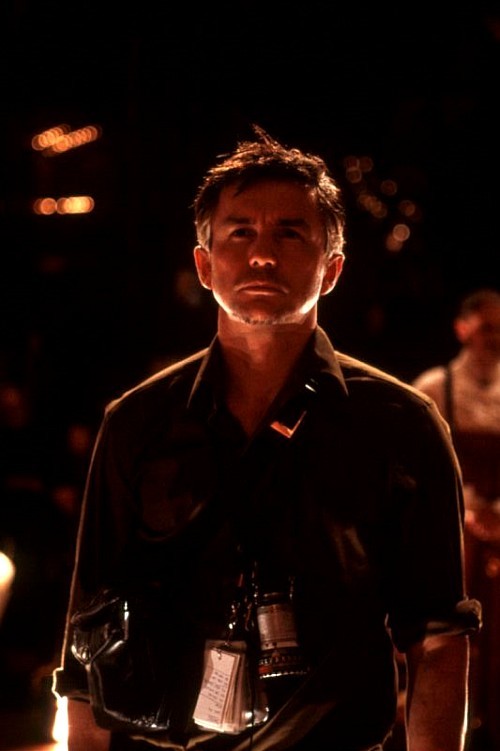
‘Moulin Rouge!’ co-writer and director Baz Luhrmann.
There is a pattern to our most emphatic reviews for the film: they come from relatively young people, who mainly identify as women. It’s something critics anticipated back in 2001. The New York Times wrote, in a fairly ambivalent review, that “young audiences, especially girls, will feel as if they had found a movie that was calling them by name”. We don’t have time to fully dig into the antiquated notion that “low art” (the publication’s quippy headline for that review was “An Eyeful, an Earful, Anachronism”) is aimed specifically at women, but surely we have to ask the question twenty years on: does anyone still think this could possibly be true?
“You’re always writing for yourself, for the film you want to see,” says Pearce. “I like all kinds of different films and I think teenage girls do too.” And let’s remember, it was Harry Styles who said of the broad demographic of his fanbase back in 2017: “Teenage girls—they don’t lie. If they like you, they're there. They don’t act ‘too cool’. They like you, and they tell you.”
Robbins: “The rom-com has made the connection between song and emotional display about female pain. The Emma Thompson crying to Joni Mitchell kind of lineage has tempered musicals—people think that’s what Mamma Mia! is: women and mothers and daughters and feelings.” Dig a little deeper and you’ll find a lot of musical-related data suggesting a broader scope. “When I went to see Frozen on Broadway, kids of all genders were wearing Olaf costumes, much more than princess ones. That is not the narrative Disney would like. And when people gender musicals and think of the princesses franchises, they don’t look to the fact that The Lion King and Aladdin were more successful.”

There has been an undeniable effort to reel male audiences in to see 21st-century musicals. On Hugh Jackman’s welcome, flamboyant career pivot (surprising to anyone but Australians), Duffy says: “Casting Wolverine in Les Misérables and The Greatest Showman is very, ‘See, manly men can do it too!’” Let’s not forget that Ewan McGregor had gotten his big break as freewheeling heroin addict Mark Renton in Danny Boyle’s Trainspotting just six years prior to playing Christian.
Indeed, says Duffy, “more of my male friends have seen Moulin Rouge! than other musicals. The MTV tone might have been significant, and there was the ‘Lady Marmalade’ music video—the fact you have all these beautiful pop stars writhing around in corsets. And just having David Bowie on the soundtrack is like, ‘Okay, this isn’t just girl music.’ Pop music offers an easier way to move past the stigma of show tunes.”
Crucially, Robbins notes that all of this prejudice, and the effort to tear it down, is speaking to, and about, a very specific—cisgender, heterosexual��subsection of audiences. “I always wonder where the critics think the queer audiences are. I do wonder if there’s a cis-het vibe going on that has even more to do with it, reinforcing that norm rather than actually focusing on young girls as an audience.”

I asked my interviewees whether they thought, twenty years on, that Moulin Rouge! would be better received today—and which parts of our contemporary cinematic and musical fabric owe a debt to Luhrmann’s jukebox wonder. “We’re more receptive but we have specific demands,” says Robbins. “And today’s musicals sink or swim on whether they meet those demands. So The Greatest Showman is the Moulin Rouge! of now. I think people would be lying if they didn’t say that the cinematography in Moulin Rouge! hasn’t affected almost every movie musical that has been made since. We wouldn’t have ‘Rewrite the Stars’ if we didn’t have ‘Sparkling Diamonds’.”
Duffy agrees: “So many things that come after you can draw a line directly to Moulin Rouge!—Pitch Perfect, Rock of Ages, Happy Feet… but most significantly, Glee would not exist without this movie. The jukebox musicals of the 21st century owe everything to Moulin Rouge! and the blueprint it lays down.”
Among the films that premiered at Cannes in 2001—David Lynch’s Mulholland Drive, Michael Haneke’s The Piano Teacher—was another kooky little number: Andrew Adamson and Vicky Jenson’s animated Shrek. Two jukebox musicals in the same prestige film festival, at a moment when the genre was considered deeply uncool? What a time to be alive!

If the last eighteen months have taught us anything, it’s that we film lovers enjoy nothing more than a comfort rewatch of our favorites. Moulin Rouge! and Shrek (and French Shrek) delivered untold comfort in the pandemic—but they had also soothed us much earlier, in the months following the unspeakable tragedy of the 9/11 attacks.
“For me it was very much a comfort film,” recalls Duffy, who had discovered Moulin Rouge! as a fresh-faced eighteen-year-old, during her first year away from home, studying in New York. “Part of that was rooted in this really traumatic thing that had happened, and all of us wanting to escape into this fantasy world as much as possible.”
Luhrmann said, in his recent Australian interview, “I love to see people united and uplifted and exulted. It’s a privilege to be a part of helping people find that.” As life outside our homes resumes, Moulin Rouge! will very much be part of a return to exultant living. The live musical—interrupted by Covid—opens in Melbourne in August and on the West End and Broadway in the fall.
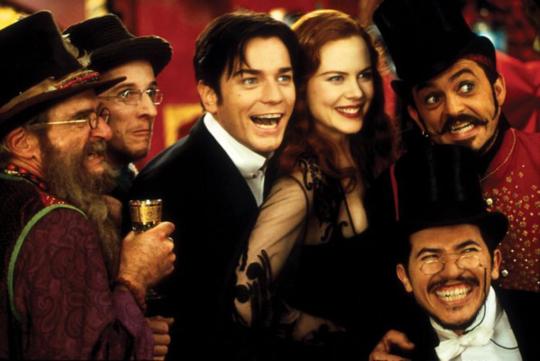
Pearce last saw the film on a large screen in a derelict warehouse in London, at Secret Cinema’s interactive, carnivalesque spectacular. “I have to say, I was really proud of the film,” the screenwriter says, finally letting himself speak fondly of his accomplishment well over an hour into our conversation.
“I mean, some people liked it back in the day, but you’re never really satisfied with your work. You just tend to see the things that could have been better. But seeing the love for the film was really, really emotional.”
Related content
Follow Ella on Letterboxd
Craig Pearce is currently producing ‘Pistol’—a biopic miniseries on the Sex Pistols, directed by Danny Boyle—and his next film with Luhrmann is a biopic of Elvis Presley, with Austin Butler playing the king of rock and roll. Additional thanks to Dr. Eleonora Sammartino, Lisa Duffy and Dr. Hannah Robbins.
#moulin rouge#moulin rouge!#baz luhrmann#catherine martin#nicole kidman#ewan mcgregor#children of the revolution#truth beauty freedom love#musical#movie musical#jukebox musical#paris#australian director#letterboxd
8 notes
·
View notes